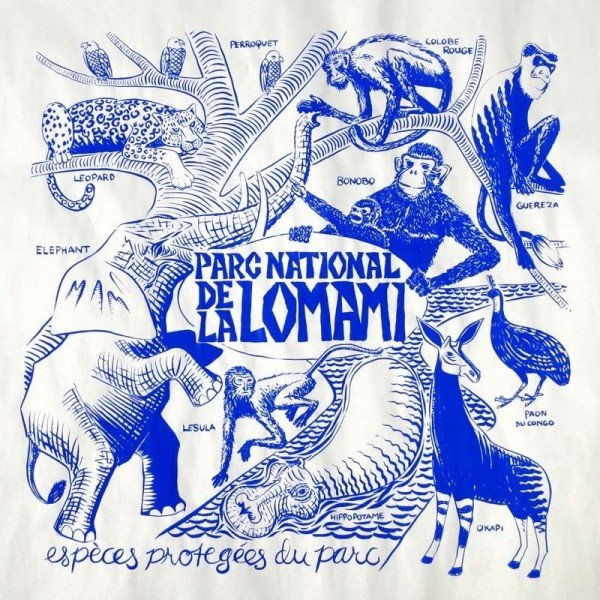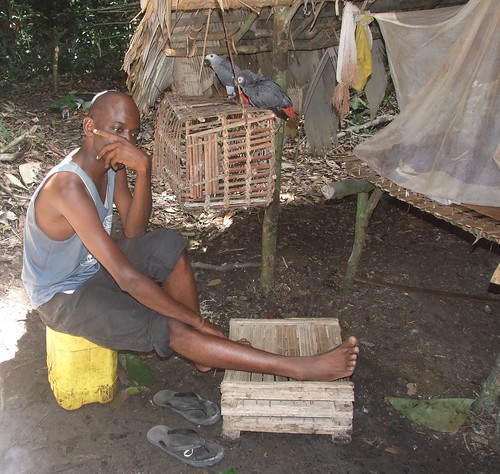In the wake of the unfortunate ruling by CITES declaring that 3000 African Grey Parrots can still be legally removed from their West African forests and exported each year – despite the overwhelming support shown to the World Parrot Trust’s petition (over 41,000 signatories) to end all trade in grey parrots from Cameroon and the Democratic Republic of Congo (DRC) – I wanted to share with you an artist who has created a project to help with wildlife identification (and ultimately raise conservation support) in the Democratic Republic of Congo – the very place the Greys fly wild.
Meet Roger Peet. He is an artist and printmaker in Portland, Oregon. His work primarily addresses “issues of ecology and biodiversity, and what it’s like to live in this period of mass extinction”. He is a member of the Justseeds Artists’ Cooperative, which is a group of 26 North American artists creating socially and environmentally engaged artwork.
Roger will be heading over to the DR Congo this fall, taking with him about four hundred bandanas to hand out to the people who live near the new Lomami National Park in eastern DRC in an effort to help foster pride and a desire for conservation in the local people of their quickly disappearing wildlife (including, of course, African Grey Parrots).
Watch his project video here:
Why the Lomami National Park is so important.
Roger writes, “The new Lomami National Park in eastern DR Congo is a unique and exciting project. While many parks and preserves in poor countries are established by decree from someone high up the political ladder, the people who live in the forests and on the riverbanks of the Lomami river in eastern DR Congo are doing something different. In Lomami, the local people are part of the process. They have agreed, in collaboration with a team of Congolese and US scientists, to set aside a large tract of forest for a new national park.”
These scientists include Drs. John and Terese Hart, who maintain the extremely informative blog Bonobo In Congo, which has some of the only parrot poaching photographs I have seen. Photos of the poachers, the way they go about catching the parrots, and how the parrots are shipped out in huge wooden crates on the backs of trucks. The scenes documented on this blog provide specific coverage of the parrot-poaching situation in the region of the new park.
The current state of conservation in Congo today.
When I asked Roger about the current situation in Congo, he responded:
“As far as the current situation goes, the efforts to establish the park center on monitoring populations of species, and on determining rates and intensity of poaching. The efforts to encourage a sense of pride and ownership of the park among local people are, I believe, perhaps the most effective tactic to be taken to diminish hunting/poaching pressure on all the park’s species, including parrots.
That, of course, in concert with efforts to disrupt the criminal networks that finance the trapping and export of rare species. This is being done, now, to ever greater success in a lot of central African nations (check out www.laga-enforcement.org) but not, sadly, in Congo. Congo’s vastness, reputation for corruption and decades of violent instability have made similar progress there difficult. Hopefully the park project will be a step in the right direction.”
And this is where the bandanas come into play:
Roger explains his project and how it will help both the Congolese people and the wildlife:
I’m going to do a detailed pen-and-ink drawing of the protected species found in Lomami National Park and screen-print it, by hand, onto about 400 big bandanas in a variety of bright colors. I’ll travel to Congo this fall to volunteer with the park team, surveying the forest and monitoring poaching in the area. While I’m there, I’ll be handing out the bandanas to whomever wants one.
…The point of these bandanas is to create a bright picture of the park’s protected species, in a format that will remain visible in communities and villages over time, a beautiful object that is at the same time a useful tool.
On a personal note, Roger shared this memory with me:
…the subject of Sub-Saharan African parrots is dear to me because of a story that my mother (who spent years living in various African nations) used to recount about an African Grey that she had as a pet while living in Nigeria. He became confused one day after missing his perch and flew off, only to be found several days later by my mother in a cockfighting pit in downtown Calabar with fighting spurs strapped to his ankles.
Want to help Roger help the African Grey Parrots (and other wildlife) and even get a bandana for yourself? To help raise funding for his venture, Roger has created a Kickstarter Project.
As a reward for your donation to the Art Bandana Project, you could get a bandana, a hand-made block print, a postcard directly from the Congo, a one-of-a-kind cut-paper illustration of a species of your choice, or even a Congolese dinner cooked for you by Roger himself. Sign up, choose a donation level, and know that you are supporting a great cause, a socially-conscious artist, and African Grey Parrots.
Educating the people in Congo – making them understand why the animals need their protection – is (I believe) the only way to create lasting support from the population for long-term conservation goals. Only by getting local support and awareness will the parrots be saved from the fate CITES has currently handed them.
Join the Art Bandana Kickstarter Project here:
- The Bandana Kickstarter Project – support the project. I did 🙂
- Interview with Robert Peet on MongaBay
- Too Sphexy – Roger’s website
- Roger Peet on Flickr
- Just Seeds Artists’ Cooperative
- Bonobo in Congo
- Moving hundreds of parrots out of TL2 – photos of a shipment of parrots through Kindu.
- Cleaning Congo’s Parrots out of Congo – photos of a “parrot merchant” and methods of trapping parrots
- Lomani National Park / TL2 landscape
- World Parrot Trust’s Call for the CITES Secretariat to Suspend Trade in Grey Parrots from Cameroon and DRC
- Read more about The Congo






One Response to Bandanas Promoting (Parrot) Conservation in DR Congo